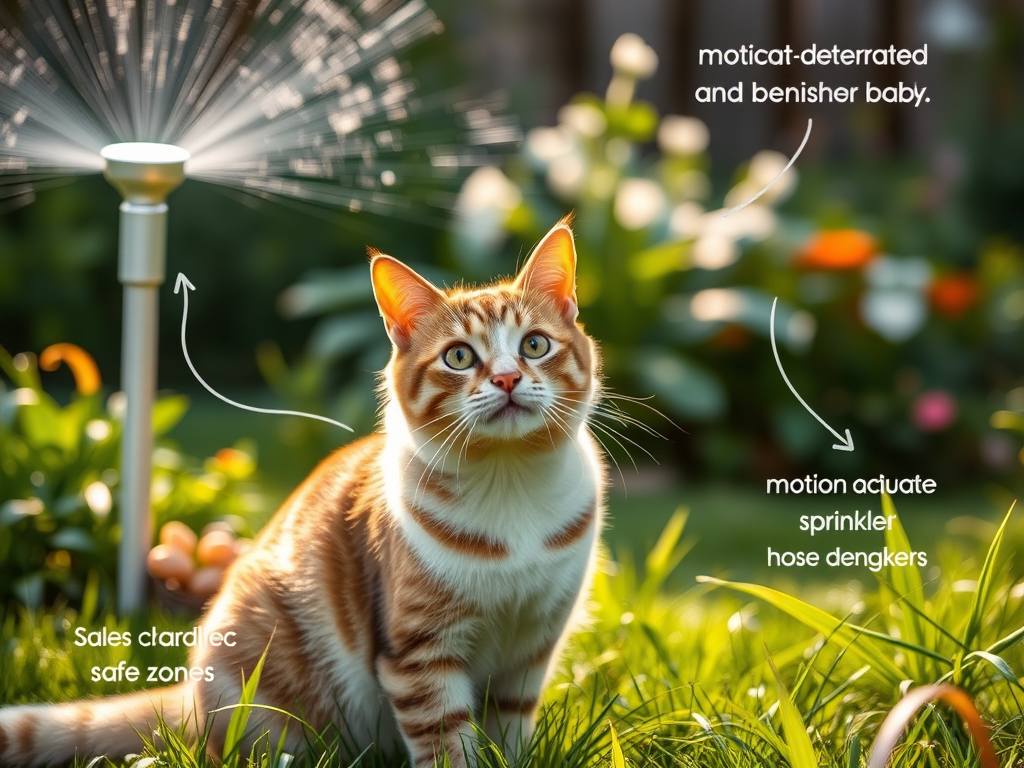Mastering Indoor Enrichment: Strategies to Satisfy Your Cat’s Hunting Instincts
Mitigating Your Cat’s Hunting Impact: The instinct to hunt is a fundamental aspect of a cat’s nature, rooted in their evolutionary history. While this behavior is entirely natural, it’s crucial to foster a safe indoor environment that accommodates their predatory tendencies while protecting local wildlife. By creating stimulating areas filled with engaging activities that activate their senses and instincts, you can keep your feline friend both mentally and physically stimulated. This not only leads to a more fulfilled and happy cat but also ensures that they remain safe from the dangers that exist outside their home.
Utilizing interactive toys can significantly enhance your indoor cat’s hunting experience. Options such as feather wands, laser pointers, and battery-operated mice are designed to capture your pet’s attention for extended periods. These toys replicate natural hunting scenarios, allowing your cat to engage in stalking, chasing, and pouncing, which provides essential mental stimulation and physical exercise. Interacting with these toys not only entertains your cat but also contributes to their overall health by allowing them to expend energy in a constructive way, thus keeping them fit and engaged.
Revitalize your living space by designing a feline adventure course that incorporates diverse structures such as boxes, tunnels, and shelves. This makeshift jungle gym encourages exploration and promotes physical activity, prompting your cat to climb, jump, and navigate different environments. Cats are naturally curious creatures, and by providing them with varied play areas, you can simulate a thrilling natural habitat, allowing them to feel as if they are on an exciting safari right in the comfort of your home.
Don’t overlook the power of puzzle feeders in keeping your cat mentally engaged. These innovative feeding devices present challenges that mimic the effort required in hunting. By incorporating treat-dispensing puzzles into your cat’s daily routine, you not only keep their minds active but also create a fun and rewarding mealtime experience. This approach encourages healthier eating habits, as your cat learns to work for their treats, making the entire feeding process more stimulating and engaging.
Establishing a routine that prioritizes playtime is essential for any cat owner. Engaging in social play is vital for enhancing the bond between you and your feline companion. Make it a point to schedule regular play sessions, utilizing the same toys that they enjoy during solo play. This shared experience not only relieves any pent-up frustration your cat may experience but also deepens your emotional connection, transforming playtime into a rewarding and enjoyable experience for both of you.
With a touch of creativity and commitment, you can craft a captivating indoor environment for your cat. Your home can evolve from just a shelter into a dynamic space that satisfies their inherent hunting instincts while ensuring their safety from outdoor threats. By thoughtfully planning and considering their needs, you can cultivate a joyful, fulfilled indoor cat.

Leash Training Your Cat: Unlocking Safe Outdoor Exploration
Implementing leash training can open up a world of safe outdoor adventures for your cat. While walks are often associated with dogs, cats can also experience the joys of nature with the right approach and patience. By gradually introducing your feline friend to a harness and leash, you can provide them with the opportunity to explore the great outdoors while remaining secure and under your supervision.
Begin your leash training journey with a well-fitting harness that prioritizes your cat’s comfort. Allow your pet to familiarize themselves with the harness before attempting to put it on. Let them explore, sniff, and investigate the harness to help alleviate any anxiety they may have. Gradually introducing the harness at their own pace fosters a positive association, making the entire process smoother and more enjoyable for both of you.
Once your cat is comfortable wearing the harness, attach a lightweight leash and practice in the safety of your home. This familiar environment will help your feline adjust to the sensation of a leash, building their confidence along the way. Be patient, as some initial resistance is common; your understanding and patience are key in helping your cat acclimate to this new experience.
When venturing outside for the first time, choose a calm and secure location, such as your backyard or a quiet park. Ensure the area is free from heavy traffic and distractions, allowing your cat to feel secure. Start with short outdoor sessions to avoid overwhelming your pet, gradually increasing the duration as they become more comfortable exploring their new surroundings.
Supervised outdoor time greatly enriches your cat’s life, enabling them to delight in the sights, sounds, and scents of nature while simultaneously protecting local wildlife. Imagine the joy on your cat’s face as they encounter new experiences in a secure setting. This shared outdoor time enhances not only their quality of life but also strengthens the bond between you and your beloved pet.
Real-life anecdotes from fellow cat owners can provide inspiration. Many have shared their initial doubts about whether their cats would adapt to leash walking, only to discover that consistency and positive reinforcement were game-changers. Celebrate each small victory as a step toward broadening your cat’s horizons while ensuring their safety and well-being.
By incorporating leash training into your cat’s routine, you create a harmonious blend of outdoor enjoyment and wildlife protection. This balanced approach allows your cat to explore their surroundings while fostering a sense of security in their environment.
Creating Safe Outdoor Spaces: The Benefits of Catios for Your Feline Friend
Outdoor cat enclosures, commonly referred to as catios, present an ideal solution for adventurous cats seeking outdoor experiences without the associated risks. These secure spaces allow your cat to enjoy the great outdoors while ensuring their safety and that of local wildlife.
When constructing or purchasing a catio, customization is key to fit your available space and budget. Options range from simple balcony enclosures to elaborate backyard structures. The primary focus should be on ensuring the enclosure is escape-proof, as safety is paramount in providing a secure environment for your cat to thrive.
When designing your catio, incorporate multiple levels and cozy hiding spots to create an engaging environment. Cats thrive in spaces with vertical options and secluded areas for retreat. By adding platforms, ramps, and hammocks, you can transform a basic enclosure into an exciting paradise that mimics their natural habitat, allowing them to explore and play freely.
Enhancing the sensory experience within the catio is equally important. Incorporate elements such as cat grass, scratching posts, or logs to create a stimulating environment filled with diverse textures and scents. This sensory enrichment keeps your cat engaged and happy while allowing them to enjoy the outdoors in a controlled and safe setting.
Regular maintenance is crucial for ensuring the safety of your catio. Routinely inspect the structure for wear and tear, paying close attention to the integrity of the mesh, overall structure, and locks. Cats are naturally curious and may test the boundaries of their enclosure, so keeping it in good condition is essential for their safety and well-being.
With a catio, your feline companion can bask in the sun, climb, and observe wildlife without posing a threat to local ecosystems. They can relish the outdoors while remaining safe, enjoying the thrill of watching birds and other small creatures from their secure haven.

Effective Training Techniques to Curb Your Cat’s Hunting Behaviors
Teaching your cat to reduce their hunting behaviors may appear challenging, but with the right techniques, it can be more manageable than you think. The initial step is to comprehend the natural instincts and behaviors that drive your cat to hunt, as this understanding is essential for implementing effective training strategies.
Utilizing technology can greatly enhance your training efforts. Consider using motion-activated deterrents, such as sprinklers or noise-makers, to establish boundaries that discourage hunting without interrupting other activities. Strategically zoning your yard into safe areas can help redirect your cat’s focus away from potential prey, ensuring they remain safe while enjoying their outdoor time.
Positive reinforcement is a key element in modifying your cat’s behavior. Reward them for displaying non-hunting actions with treats or affection. For instance, if your cat responds when called or refrains from chasing a potential target, reward them with a tasty treat or extra attention. This approach encourages them to repeat desirable behaviors while diminishing their instinctive urge to hunt.
Incorporating clicker training can also prove to be an effective method. This technique involves associating a distinct sound with positive actions, enabling your cat to make connections between their behavior and rewards. By clicking when they exhibit desired actions, you can reinforce good habits and clearly communicate your expectations.
For more individualized assistance, consider consulting with feline behavior specialists. They can provide tailored advice and insights that address specific challenges, helping you and your cat coexist harmoniously while respecting local wildlife and their habitats.
The goal of using deterrents and training is not to punish but to guide your cat toward behaviors that prioritize both their safety and the environment. With patience and consistency, you can successfully redirect their instincts, leading to safer outdoor interactions for both your cat and local wildlife.
Nutritional Approaches to Mitigate Hunting Drives in Cats
The type of food you provide and the feeding methods you adopt can significantly influence your cat’s hunting instincts. Interestingly, even a well-fed cat may still display hunting behaviors; however, the way you feed them can help diminish this drive effectively.
Free feeding, where food is available continuously throughout the day, might not be the most effective approach for every cat. Instead, consider implementing a structured feeding schedule. By establishing predictable mealtimes, your cat may become less inclined to hunt, as they learn to associate food with specific times of the day, thereby reducing their need to seek out prey in the wild.
Utilizing interactive feeding strategies can be transformative for your cat’s behavior. Using food puzzles or dispensers can simulate the act of hunting, requiring your cat to ‘earn’ their meals. This not only keeps their minds engaged but also channels their energy positively, allowing their natural instincts to be expressed in a safe manner.
It’s also essential to pay attention to the nutritional content of their diet. A high-protein, low-carbohydrate diet aligns better with a cat’s natural dietary needs, potentially leading to a decrease in hunting behaviors. Collaborating with a veterinarian to customize your cat’s diet can ensure that their nutritional requirements are met effectively.
Lastly, providing a variety of food types can satisfy their innate curiosity and appetite for novelty. Alternating between dry kibble, wet food, and raw diets can keep mealtime interesting, reducing the urge to seek excitement beyond their food bowl.
Feeding strategies go beyond mere sustenance; they act as a powerful tool for managing your cat’s behavior. By adjusting how and what you feed them, you can effectively curtail their inclination to hunt while ensuring they remain satisfied and healthy.

Community Responsibility: Protecting Cats and Wildlife Together
Cats are cherished companions, and as their caretakers, we bear the responsibility to ensure they coexist peacefully with local wildlife. By embracing community involvement and personal accountability, we can significantly reduce the ecological impact of free-roaming cats on their environment.
Engaging with local conservation groups is an excellent way to stay informed about wildlife-friendly practices. Many communities offer educational workshops for cat owners, discussing the ecological consequences of allowing cats to roam freely and providing practical solutions to mitigate these effects.
Consider initiating or participating in neighborhood discussions or social media groups focused on responsible pet ownership. Sharing resources, tips, and experiences can foster a more wildlife-conscious community, creating a supportive environment for all pet owners and their furry friends.
A proactive approach includes establishing cat-friendly zones within communal gardens or parks. These designated areas can feature enclosures or supervised play spaces, ensuring a safe environment for both cats and wildlife. This collaborative effort promotes awareness and encourages positive interactions between pets and nature.
Incorporating family-friendly initiatives, such as sticker campaigns or educational contests for children and teens, can help raise awareness about responsible pet ownership and the importance of coexisting with the natural world.
Lead by example within your home by applying the strategies you’ve learned. Whether it’s leash training, constructing catios, or modifying feeding habits, demonstrating a commitment to fostering a harmonious relationship between your cat and the environment can inspire others to follow suit.
By combining individual actions with community initiatives, we can create a supportive network that balances our cats’ needs with ecological stewardship. Together, we can cherish our pets while respecting and protecting the wild spaces around us.
The Article: Minimize Your Cat’s Hunting Impact Appeared First On Unity Pets.
The Article Minimize Hunting Impact of Your Cat Effectively Was Found On https://limitsofstrategy.com
The Article Effectively Minimise Your Cat’s Hunting Impact First Appeared ON
: https://ad4sc.com
Comments are closed